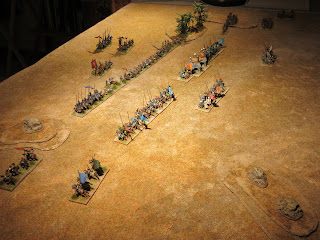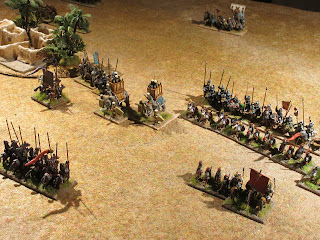Following the end of the Roman civil war of 432, Aetius, now comes et magister utriusque militiae, devoted his attention to restoring the political situation in Gaul. The Burgundi of King Gundacar would be a first priority; however, some sources indicate this was completely executed by Hunnic forces. No Roman forces are mentioned in the sources nor strengths listed other than the alleged figure of 20,000 Burgundi killed, including King Gundacar (Hydatius).
These games bring the Huns (II/80d) in contact with the Burgundi (II/70a) both are double size commands of 24 elements each. Terrain pieces placed by the defender are one village, a difficult hill and two wood and road.
Game one
The
Burgundi take a defensive position using a difficult hill and wood to secure their
flanks. As an extra precaution, troops are positioned on the far right to deal
with any enemy flanking attempts. This proved prudent as the arrival of the
Hunnic horde extended beyond that of the Burgundi.
As anticipated, the Huns probe the Burgundi right for any weaknesses.
In a surprise move, the Burgundi advance their battle line exposing their left for a brief moment. The gap was quickly sealed tight by warriors from the second line.
The approaching Burgundi threatened the Hunnic centre, but this did not deter the fighting on the flanks. Casualties mounted equally for both armies.
In a desperate attempt to deal the final blow, the Burgundi charged the enemy centre with convincing effect. The Huns withdrew from the field to make plans for another day. Burgundi 8 – 6.
Game two
The
Burgundi formed two wings of equal strength and positioned them on either side
of a village. The Huns placed the majority of their force facing the Burgundi
right while a second force, led by a sub-general, would probe the Burgundi left.
The Burgundi began the battle by sending skirmishers to seize the hill. From there, they could harass the enemy cavalry on either side, however, the attempt proved fatal, as they were intercepted near the base of the hill. Pressing an advantage, the Huns engaged the Burgundi left.
The majority of the battle took place against the Burgundi left with the Burgundi right remaining in position as the Hunnic main body remained still. During the battle, the loss of the sub-general meant the collapse of the Burgundi left. A general retreat was called and with the majority of the Hunnic force not employed, they would be eager for the pursuit. The Huns 8 – 3.
Observations.
Game one proved a challenge as the Burgundi took
the offensive to assault the Hunnic centre. This created a dilemma for the Huns
being committed to a two-pronged attack against the Burgundi flanks leaving its
centre inert. Scrambling to recover, the Hun readied its centre leaving the
flanks vulnerable. This proved fatal forcing the Hun to retreat.
Game two was a complete disaster for the
Burgundi. Low pip scores resulted in the Burgundi remaining motionless throughout
the battle in contrast to the Huns, who enjoyed the day. In close combat,
warband fighting mounted have the same combat tactor, however, Hunnic mobility
proved effective to strike exposed flanks or supporting an element already
engaged.



































